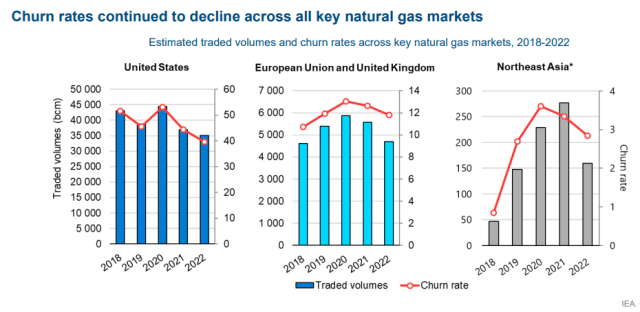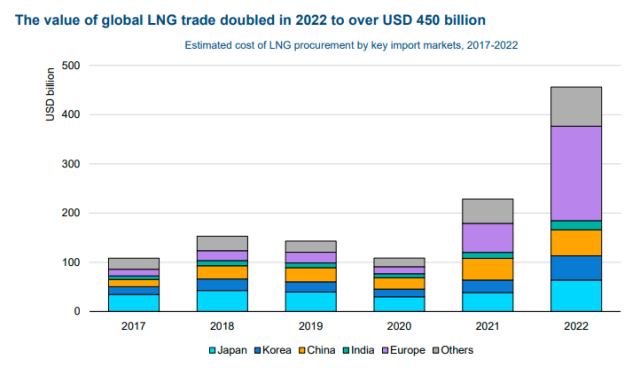The latest IEA report said the value of global LNG trade has doubled in 2022 to an all-time high of $450 billion despite rising by 5.5 percent in volume terms.
The energy and gas crisis triggered by Russia’s invasion of Ukraine drove up spot gas prices and LNG import bills to record levels across key Asian and European markets.
Gas and LNG producers’ record profits could support additional investment in reducing the emissions intensity of gas value chains, enhancing methane capture efforts and diversifying economic structures to adapt to the new global energy economy that is emerging.
LNG played a critical role in mitigating the impact of Russia’s cuts in piped gas supply to the European Union and was instrumental in avoiding gas supply shortages in 2022. The competition for flexible LNG cargoes between Asia and Europe provided upward pressure on hub and LNG spot prices.
In Europe month-ahead prices on the TTF averaged over USD 40/MBtu in 2022, almost eight times their five-year average between 2016 and 2020. In Asia LNG spot prices followed suit, averaging at USD 34/MBtu over the year, more than five times their five-year average between 2016 and 2020.
 Consequently, the estimated value of LNG traded under spot mechanisms – more than doubled to over USD 230 billion. Geopolitical uncertainty and tightening supply drove up oil prices to their highest level since 2013. This placed upward pressure on oil-indexed LNG contract prices, which rose by 70 percent in 2022 to an estimated average of USD 15/MBtu.
Consequently, the estimated value of LNG traded under spot mechanisms – more than doubled to over USD 230 billion. Geopolitical uncertainty and tightening supply drove up oil prices to their highest level since 2013. This placed upward pressure on oil-indexed LNG contract prices, which rose by 70 percent in 2022 to an estimated average of USD 15/MBtu.
Hence, the value of LNG traded under long-term oil-indexed LNG contracts – approximately 60 percent of global LNG trade – rose by 90 percent to an estimated USD 220 billion. Markets with greater exposure to spot procurement experienced a sharper increase in their LNG import prices. The weighted average import price in Japan and Korea, which rely predominantly on longterm, oil-indexed contracts, rose by 80 percent to USD 19/MBtu in 2022.
In contrast, the import price of the United Kingdom, heavily reliant on spot procurement, almost tripled compared with 2021 to an average of USD 28/MBtu.
 Europe’s LNG procurement costs more than tripled to an estimated USD 190 billion, and accounted for 60 percent of the total increase in the global LNG import bill. The region’s LNG imports soared by over 60 percent (almost 70 bcm), while the estimated LNG import price more than doubled.
Europe’s LNG procurement costs more than tripled to an estimated USD 190 billion, and accounted for 60 percent of the total increase in the global LNG import bill. The region’s LNG imports soared by over 60 percent (almost 70 bcm), while the estimated LNG import price more than doubled.
The combined LNG import bill of Japan and Korea rose by 80 percent to close to USD 115 billion, while LNG imports declined by 2 percent compared with 2021.
China’s LNG procurement costs rose by almost 20 percent to over USD 50 billion, despite a decline of 20 percent in the country’s total LNG imports.
LNG supply growth was relatively modest in 2022 at 5.5 percent, despite an unprecedented rise in LNG demand in Europe following the gradual decline in Russian pipeline gas deliveries throughout the year.
The utilisation rate of global liquefaction capacity averaged 84 percent in 2022, unchanged from 2021 levels and slightly above the 2017- 2021 average of 83 percent. However, the rate in H2 2022 (at 82 percent) was markedly lower than during the first half of 2022 (at 87 percent).
LNG carrier orders reached an all-time high of 165 (+130 percent) in 2022, according to data from Refinitiv. Strong demand and limited capacity at Korean shipyards until 2027 led to price increases for new-build LNG vessels (surging to more than USD 250 million by the end of 2022 vs USD 200 million at the end of 2021). This has boosted the presence of Chinese players in the LNG shipbuilding market: Chinese yards received orders for as many as 57 new LNG vessels in 2022, another record and more than a fivefold increase on 2021, according to Refinitiv.

